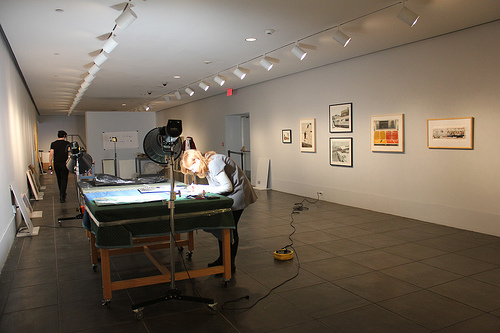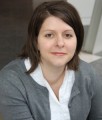Creating a Framework to Collaborate with the Public
You have been following us from the 1708 studios to 9,457 nominations to 10 nominees to the 5 featured artists. Let’s take a look at how we got here.
Over the past year and a half, we discussed many ways to approach the exhibition, including whether or not the exhibition was necessary. In the process, we considered various models. For instance, we have already mentioned the inspiration provided by ArtPrize and our interest in modifying their framework to see work within the context of the studio and to require voters to nominate fewer artists. We also looked at the Walker Art Center’s 50/50: Audience and Experts Curate the Paper Collection, an exhibition that invited the public to vote on a selection of images on a kiosk at the museum and online, while their chief curator chose works by artists represented in depth in the museum collection. The resulting selections were hung in two sections, sparking “a range of questions about the dynamics between ‘audience’ and ‘expert,’ or between curatorial practice and so-called ‘mass taste.’” By contrast, the Hammer’s new Mohn Prize awardee was chosen by public vote from the museum’s Made in L.A. biennial exhibition. The experts, a jury of curators, winnowed the pool from the 60 exhibiting artists to 5 before inviting the public to vote. This model shifts the weight of decision making toward the experts. We also considered our own past projects, particularly Click! A Crowd-Curated Exhibition. While Click!, a great success, has served as a model for many subsequent projects elsewhere, it focused on using the internet as a tool and the photographs, though Brooklyn-themed, were judged online and in isolation. During GO, we wanted to shift the focus more toward seeing a body of work in the studio with the artist present while creating an awareness of the art-making taking place in various communities throughout Brooklyn.

Installation of GO started on Monday in our Mezzanine gallery on the second floor of the Museum.
Since the main objective of GO was to connect the community with the vast number of artists working in their neighborhoods, the process included meeting and talking to artists face-to-face as well as scores of opportunities to encounter art in the flesh, so to speak. We invited the public into artists’ studios and asked it to nominate artists, creating the shortlist of artists for me and Eugenie Tsai to visit and select for the show, creating a collaboration between members of the community and the museum curators.
As always, practical issues arise. With exhibitions, the issue is always one of available space during the preferred period of time. We wanted the exhibition to follow the open studio weekend as quickly as possible and estimated that the entire process would take about three months, putting the opening in early December. We also felt strongly that unveiling the show on a First Saturday would be in keeping with the community-spirited character of the show. We felt now was the right time with Brooklyn experiencing such a great renaissance and with such widespread enthusiasm for the incredible creativity in the borough.
More to come this week!

Sharon Matt Atkins joined the Brooklyn Museum in 2009 and is the Managing Curator of Exhibitions, overseeing the Museum’s exhibition program. She is the co-organizer of GO: a community-curated open studio project, with Shelley Bernstein. She has coordinated and facilitated numerous special exhibitions, including Andy Warhol: The Last Decade and Norman Rockwell: Behind the Camera. Prior to her move to Brooklyn, Atkins had been the Assistant Curator at the Currier Museum of Art, Manchester, New Hampshire.
